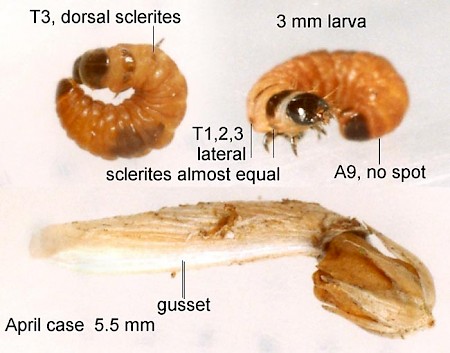37.071 BF582
Coleophora glaucicolella
Wood, 1892
Wingspan 10-12 mm.
Coleophora glaucicolella is widespread and common in Britain, but sometimes goes unrecorded because of confusion with another Juncus feeding species, C. alticolella.
It is often abundant on salt marshes.
Flight period June to August at sunrise, dusk and night.
The adults resemble several other Coleophora species and are most reliably identified by dissection of the genitalia. The full grown larval case is very similar to that of C. alticolella, but the larvae can be differentiated.
Larva: (description Ian F. Smith)
Foodplants:On the seeds of Juncus inflexus, J. gerardii and J. maritimus Sept. to May. Also on J. conglomeratus, J.effusus, J. articulatus and J. acutiflorus.
Diagnostic features to differentiate from C. alticolella are highlighted.
Case: Full grown, (May), 5 to 6 mm, pale buff with granular debris near mouth, similar to case of C. alticolella. In April, when the case is about 5.5 mm long, larvae on the plant are active. Cases that have recently been expanded have a gusset of clean white silk along the underside and appear somewhat laterally compressed.. The three crimps at the posterior end are then arranged with one on the centre of the venter and one either side of the dorsum. In Autumn, cases under 4 mm may be C. glaucicolella, as it forms its case at second instar and starts larval life two months later than C. alticolella, which delays case formation until third instar. But beware of stunted C. alticolella.
Some fast developing glaucicolella larvae have full size cases by November.
Larval length: 3 mm (April).
Head: Black.
Prothorax (T1): Prothoracic shield brownish black with a paler wide anterior border and thin medial line. Brownish black lateral sclerite.
Mesothorax (T2): Two pairs of dorsal sclerites, the posterior pair fused, brown with a central dark spot. Brownish black lateral sclerite.
Metathorax (T3): One pair of dorsal sclerites, dark brown with a dark central spot. Dark brown lateral sclerite, nearly as big as lateral sclerite on segment T1.
Thoracic legs: Brownish black.
Body: Brown with pinkish orange tint. No spot on posterior border of segment A9.
Spiracles: Brown.
Setae: Transparent colourless.
Anal plate: Brownish black.
Prolegs: Coloured as body with dark brown crochets. Anal prolegs have a large brownish black pinaculum postero-laterally.
Comment:
To extract a larva from its case, pin the case by its edges to a piece of plastazote or polystyrene meat tray. Slit the case with a needle, along the gusset if one is present. Operate slowly at alternate ends to give the larva time to withdraw from the needle. Care is needed when extracting diapausing larvae which can not retreat.

 UKMoths
UKMoths 



